5 Types Of Hooks For Writing
No matter what your business happens to be, your customers are online. You need to keep in touch with them through different channels and using various content formats. After reading this guide, you'll be ready to plan your content production and create the most popular types of content, or order them from your writers more wisely.
- What Is Content Writing?
- Types of Content
- Content Writing Basics
- Research
- Planning
- Writing
- Content Writing Tips
- Articles
- Product Content
- Website Сontent
- Email Newsletters
- Press Releases
- Ebooks
- Outsourcing Content
- Final Thoughts
What Is Content Writing?
Content writing refers to creating content for online marketing purposes. With content, businesses can attract leads and foster positive connections with their audience, ultimately pushing them down the sales funnel.
87% of marketers use content to guide their prospects through different stages of the buyer journey. They leverage different content formats for each stage of the journey, from brand awareness to purchase decisions.
Since a myriad of companies are fighting for the same audience's attention, they need high-quality, targeted content to cut through the clutter and reach potential customers.
Types of Content
Content writing encompasses many different forms of text-based content. Each type can serve a different purpose and promote the brand in a different way.
Here are the most common formats used:
- Articles
- Product descriptions (and related content)
- Website content
- Email newsletters
- Press releases
- Ebooks
These different content formats can reach potential customers at different stages of the sales funnel, so their purpose is to move that individual further toward the end goal: closing the deal (or making a subsequent sale in the case of return customers).
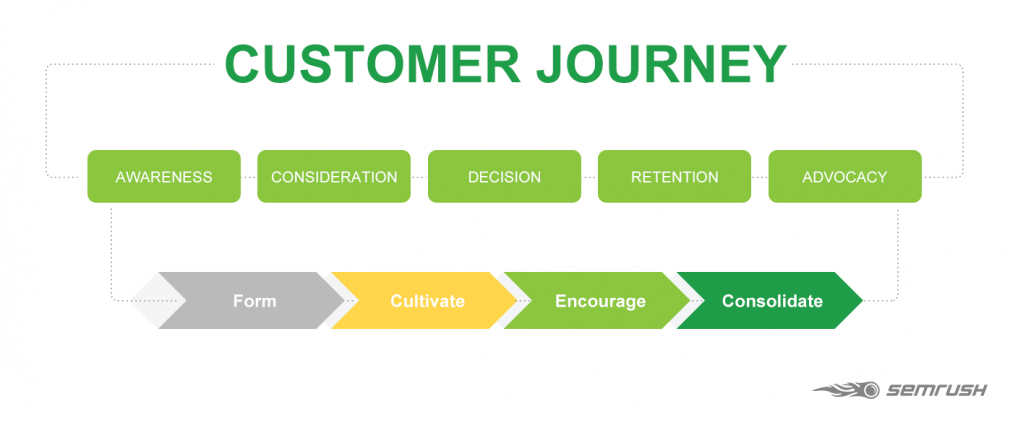
Each of these content formats requires different talents from the writer, but there are also general rules applicable to all types of content.
Content Writing Basics
Before even choosing the topic to write about, it's essential to do the prep work. This is where content writing actually begins.
-
- Research
- 1. Business Goals
- 2. Buyer Persona
- 3. Search Intent
- 4. Keyword Research and SEO
- 5. Content Strategy
- 6. Topic Research
- Planning
- Writing
- Research
Research
Your content should reflect factual, research-based information. Companies that spread false or misleading information are vulnerable to backlash from both search engines and consumers.
According to Hill Holliday research, if a brand generated fake content about their services or products, 59% of consumers would stop buying that brand immediately. Conversely, 64% said they would be more likely to shop with that brand if they knew they were truthful about their business. Misleading content will ultimately lead to negative company and product reviews and once that occurs, a reduction in sales is a likely outcome.
Factual content, however, helps to establish your business as an authority in its field. In-depth research can guide your content creation process, preventing you from wasting your marketing dollars and losing your audience credibility.
Here is what you should research:
1. Business Goals
Think about the business goals you want to accomplish, and how you plan to use content to do this.
You should understand:
- What type of content format you need.
- What style/tone you want your piece written in.
- What your goals are for each piece.
If, for example, you want to increase organic visits, the writer will likely focus on high-volume keywords that your site can rank for.
If you want to convert readers into leads, they might create more middle-funnel content designed to capture high-intent users, and ultimately send them to a relevant lead magnet like a downloadable template or a webinar.
Defined goals that include measurable results and detailed plans for reaching specific audiences are essential. Check out our Seven Steps to Creating a Complete Content Strategy Plan for more tips on goals, KPIs, and audiences.
2. Buyer Persona
As our guide to creating a buyer persona notes, a buyer persona is an abstract depiction of your ideal customer. It is founded upon qualitative and quantitative data from market/competitor research and existing customer profiles.
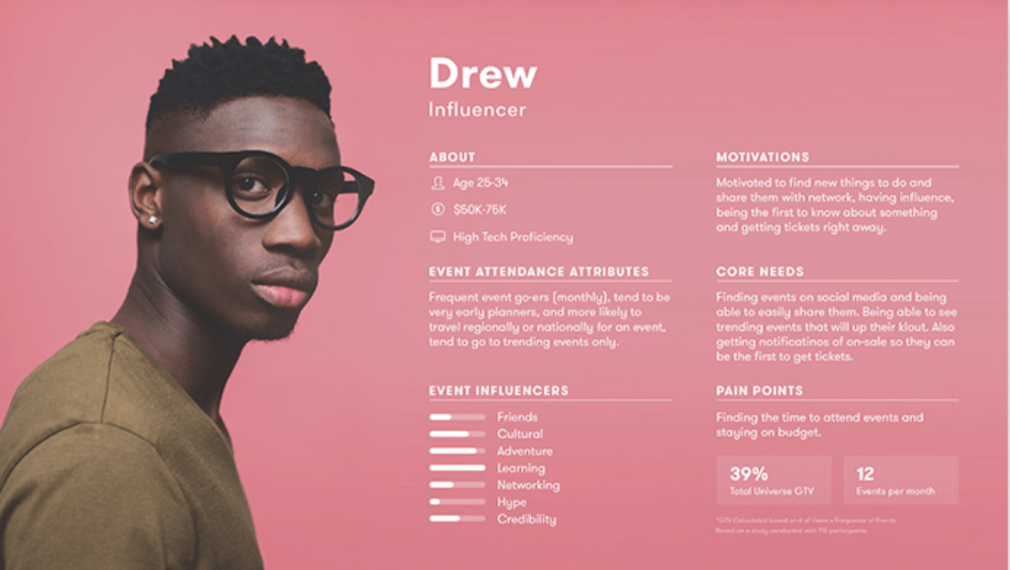
Image source: https://www.pinterest.ru/pin/327777679125490513/
Initially, marketers tend to give their buyer persona a name and a fictional avatar (photo), and then fill in the following details:
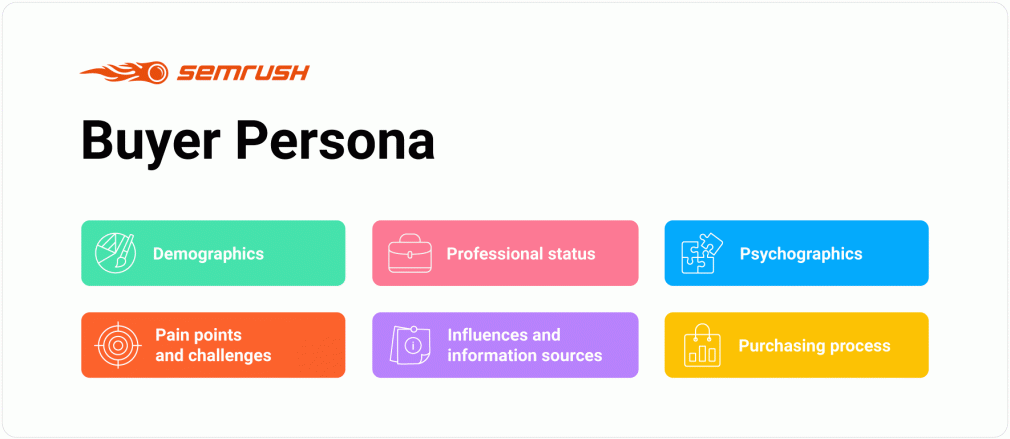
While data and online analytics tools can help you establish your customer personas, there are other methods for getting to know the most common traits exhibited by your customer base. To find them, consider:
- Creating online customer surveys
- Conducting customer interviews (by phone or in person)
- Talking to sales staff about their customer impressions
- Using form fields on your website to request customer information (such as what products they may be interested in)
- Mining social media for persona-related information
Focusing on a specific person when creating content can guide the writer and designer towards using the right language and style – your message won't get watered down from trying to address too many different needs.
Speaking of needs, it's also worth referring to search intent.
3. Search Intent
Users often have very different expectations when using search engines, and, in its guidelines, Google talks a lot about how to understand what users are looking for when using different queries. Providing exhaustive answers to user queries increases the chances of your content being rated as quality.
Search intent can be broken down into four distinct types:
- Informational – the searcher is looking for specific information on a topic.
- Navigational – the searcher is looking for a specific web page or site.
- Commercial – the searcher is considering a purchase and wants to investigate their options.
- Transactional – the searcher wants to purchase something.
To understand the search intent of your users, you need to look at the keywords that you target in your piece. We will talk about these in the next section.

4. Keyword Research and SEO
For a business, it's important to remember that, in today's digital era, content writing is closely aligned with SEO. Google and other search engines play a vital role in sending organic traffic to websites, and they value quality content.
In order to 'encourage' Google to rank your business page highly in the search results, you need to offer content that is optimized and designed to render your business as relevant for keyword searches. If your business website is loaded with generic or scraped content, it could be penalized by Google and buried three, four, or more pages back in the search results.
SEO is important not only for ranking in search, but also for proper communication with clients. Therefore, you want to select topics and keywords with both of these things in mind. In this regard, content writing supports SEO and helps businesses communicate optimally with their customers to achieve their marketing goals.
You'll want to conduct thorough keyword research for each topic you want to write about. Ideally, you should create a list of the most important and relevant keywords associated with your chosen topic. Then, you should prioritize the highest-value keywords by the keyword's search volume, keyword difficulty, and average CPC.
You can also choose to create a semantic core. This makes sense if you are working not with one article, but in a complex way - with the whole site or a section of the site. Building a semantic core means collecting all keywords related to the resource's topic, clustering them, and optimizing all pages for groups of collected keywords.

Opt for keywords that are realistically attainable for your brand, based on the domain authority of your site in relation to keyword difficulty. Tools such as Semrush's Keyword Magic Tool can help you get insightful data, enabling you to research the entire market by starting with a seed keyword.
The tool generates topic clusters, as well as lists of related terms and questions people search, which is perfect for creating a semantic core. In addition, you can rely on the 'keyword difficulty' metric; the lower it is for a keyword, the easier it will be for you to rank higher.
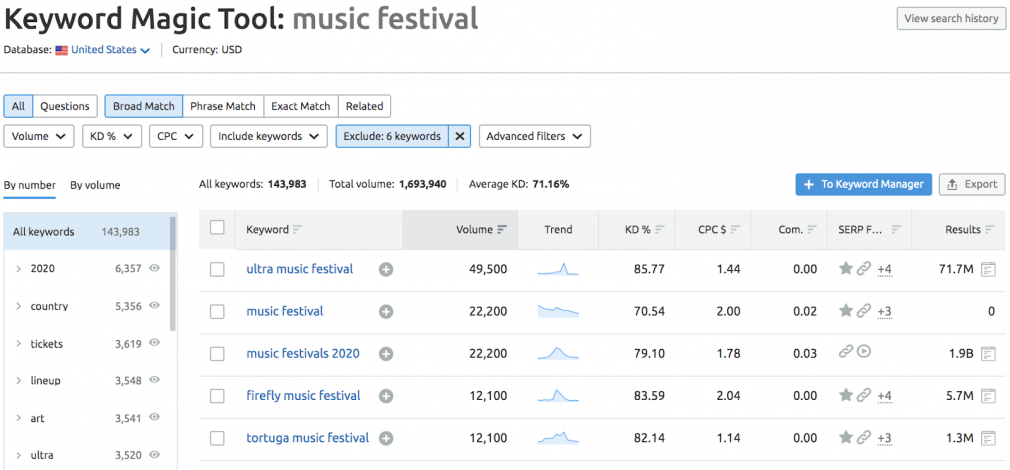
5. Content Strategy
In order to effectively engage with your audience and outperform your competition's marketing initiatives, it helps to construct a comprehensive content strategy plan. This plan refers to how you intend to manage your marketing content (i.e. where and when you plan to publish). Your content strategy should include:
- Your content formats (i.e. social media posts, articles, etc.)
- The channels you will publish on (i.e. your business website, social media networks, etc.)
- How you will manage the content (who will do the posting and manage the customer engagements)
- Content construction (who will actually do the writing? If outsourcing, what firm will you use?)
- Content performance (who will analyze how your content is performing and report back to you?)
A well-crafted plan provides a framework for creating and posting your content. Without one, your content campaign is likely to become disjointed and ineffective.

6. Topic Research
Take the time to carry out thorough topic research, so that you can come up with strong, strategic ideas for your content that will resonate with your audience and drive results.
When doing topic research, consider using the following tactics for idea generation:
- Find your audience's biggest pain points. You can do this by looking at online reviews, Google's "most asked questions," and Quora articles that are related either to a general topic or your industry overall.
- Run a survey on social media. Ask your followers what they'd love to read about, or what questions they may have.
- Conduct a content gap analysis. This looks at the keywords your competitors are ranking for that you aren't, and for the keywords in which you are being outranked by your competitors. Our Keyword Gap tool can help with this, identifying potential keywords you can use moving forward.
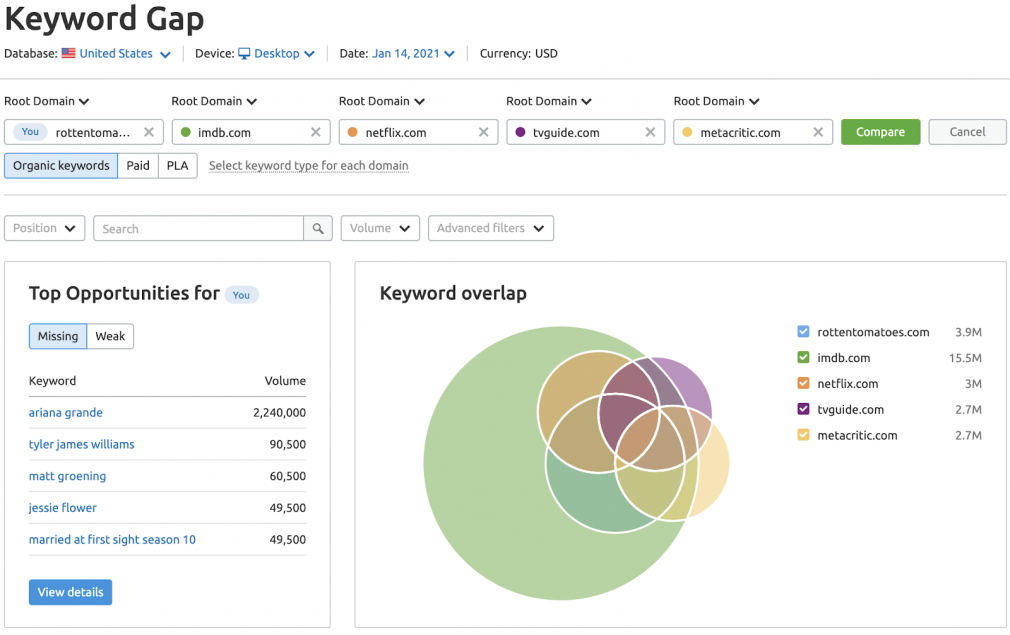
- Repurpose your competitor's content. See what's performing well for others, and look for ways that you can make your own piece more valuable and actionable, ensuring that you provide the winning resource.
- Use content ideation tools for research. Look for the hottest and potentially trending topics that you may be able to rank well for. Semrush Topic Research gives writers and strategists a helping hand with content brainstorming, generating cards on related subtopics and ideas that you can include in your content.
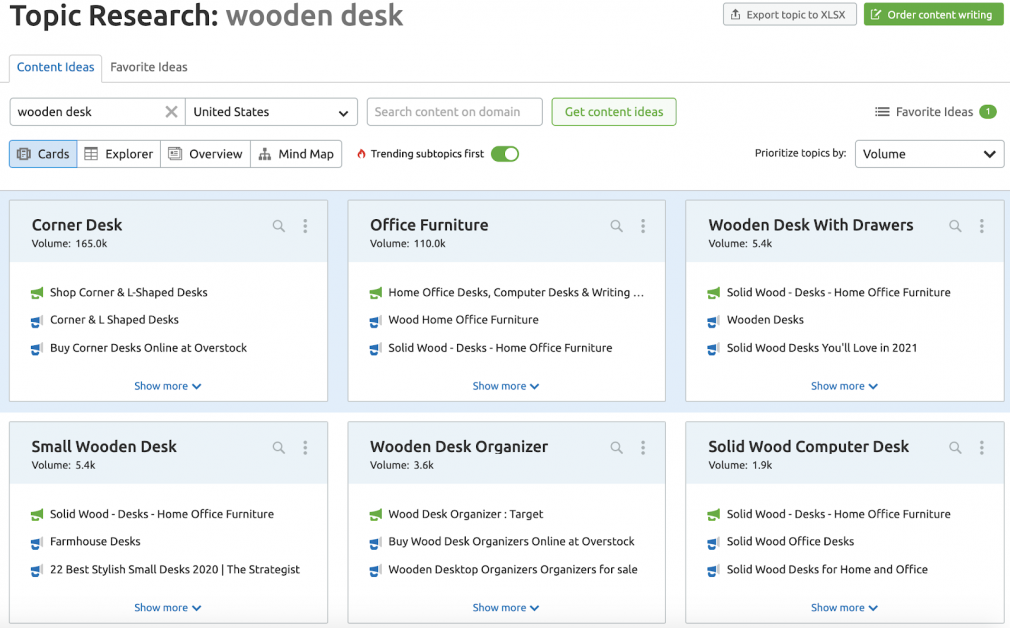
- Talk to other departments in your company. Content creation is all about teamwork, and liaising with other relevant teams (such as customer support, product managers, and commercial) helps ensure that your content arouses interest from your target audience.
Now let's get on to planning. What is the best general content planning advice?
Planning
Once you're clear about your goals, topics, content formats, respective funnel stages, and marketing channels, you can work out your content calendar.
An editorial calendar is something that content specialists, marketers, and SEO gurus can't do without, because it provides them with a clear view of their tasks:
- It allows the team to develop quality content in advance of publication time.
- It enables staff in other departments to be in the communication loop.
- It promotes posting consistency, which ultimately leads to improved communication with your customer base.
We recommend drawing your content plan and calendar on an Excel sheet, detailing the following for each individual post:
- The goals you have for the post
- Marketing promotion channels
- The chosen content type
- The topic
- Deadlines and publication dates
- Task owners or other team members involved in the process
To stay organized across multiple departments or with different clients, you could use an editorial calendar tool such as the Semrush Marketing Calendar. This streamlines the process of communication between team members during the creation, publication, promotion, and updating of content.
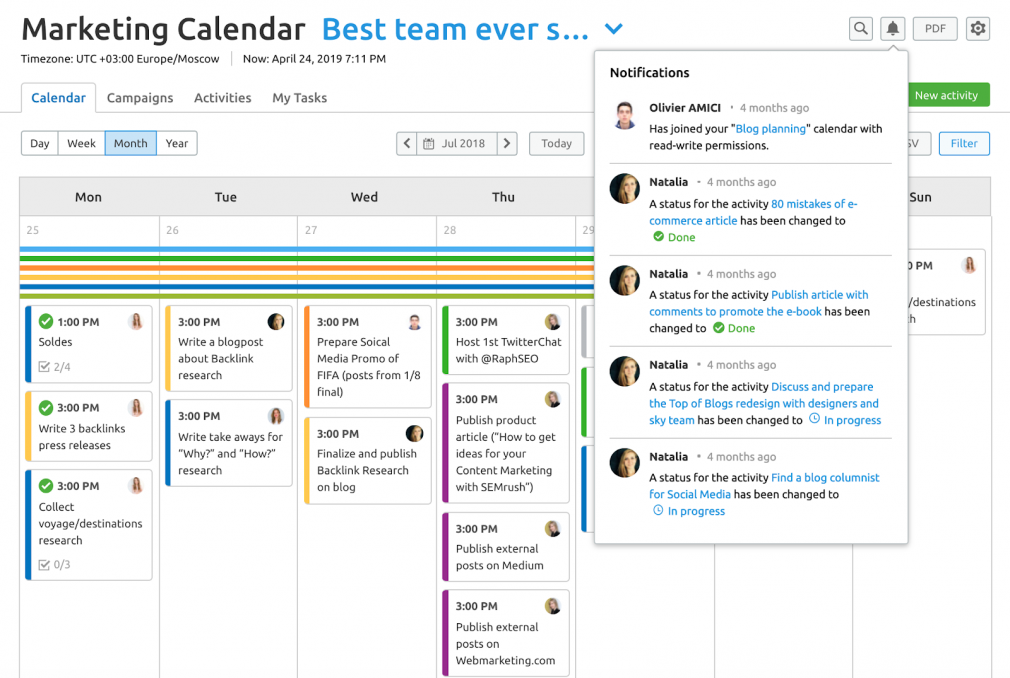
The tool also enables you to keep on top of both team tasks and deadlines, ensuring that each activity runs smoothly.
When creating a content calendar, consider the following questions to determine what your calendar should look like based on your team's needs:
- How often do you publish content?
- Do you publish more than one type of content?
- How many people need to access the calendar?
- How many content stages do you go through prior to publishing?
- What platform will you use for the editorial content calendar?
Now, let's move on to the general writing rules applicable to any type of content.
Writing
You'll want to find a writer or a group of writers that can quickly and seamlessly integrate with your marketing team to develop content that's on point with your brand and marketing goals.
Professional writers working in the marketing field know how to incorporate effective hooks, consistent tone of voice, and goal-oriented language designed to get results (i.e. increased sales).
Here are some tips that can help create content that wows your audience and, most importantly, convert them into leads:
- Make sure all content has a clear goal. Your content direction starts with what you want to accomplish and who you need to reach to meet those goals.
- Think enticing titles. You need to draw your audience into reading your content; keep your titles short and sweet, but indicate the benefit of your content.
- Hook your readers from the first line. Start your copy with some exciting data, a one-sentence story, or a question. Make people hungry for the details after reading the first line.
- Make your copy scannable. Most people skim read, so use descriptive subheadings, bulleted lists, and white space between paragraphs to ensure that the text is easily scannable.
- Use visuals. Videos, images, presentations, charts, infographics, and social media stories are highly effective ways to communicate with your audience. For example, during our recent research we discovered that the majority of tweets we analyzed contained visuals, and 20% of these contained infographics. "What is visual content marketing" is also the 11th most popular question people ask about content marketing on Google.
- Be consistent. A consistent brand voice and set of values across all your channels can help to fuel audience connection, and make your brand recognizable.
- Choose an interesting angle. Millions of pieces of content are going live every day, so what makes yours different? You need a fresh perspective that hooks readers and makes you the leading authority on that topic.
- Tell a story. Storytelling is a way to inspire, motivate, and ultimately encourage your audience to act, making it a highly valuable tool for facilitating interaction between your consumers and your brand.
- Use data. This is an excellent way to add credibility to your words.
- Repurpose old content. You can find excellent topic opportunities when repurposing content; for example, a list-based article may work well as an infographic, or an old blog post could be turned into a video for social media.
- Use calls to action (CTAs). Add a short, action-oriented phrase that convinces your consumers to act in a particular way. The action must be easy for the audience to carry out, such as buying your product or subscribing to a newsletter, for example.
- Modify the content type according to your goals. Some forms of content are better at reaching engagement and conversion goals than others. For example, in email newsletters, the subject line is crucial. Meanwhile, for product pages, things like visuals, testimonials, and detailed product descriptions are paramount.
- Keep an eye on the metrics. Make sure that you are monitoring and tracking important metrics. Content efficiency is mostly measured through organic traffic (83%) and sessions/pageviews (70%). The next most popular metrics are leads (66%), and conversion rate (53%).
- Avoid spelling, grammar, and punctuation errors. Don't forget the importance of grammar and spelling for readability and for creating trust; this is just as crucial when it comes to creating great content
Depending on your goals, you may need different types of content. Therefore, let's take a closer look at the specifics of writing each of the content types.
Content Marketplace
Get High-Quality Content From Expert Writers

Content Writing Tips
Let's take a look at the tips for writing different types of content:
-
- Articles
- Product Content
- Website Сontent
- Email Newsletters
- Press Releases
- Ebooks
Articles
In our 2020 State of Content Marketing report, over 92% of marketers stated that blog posts were the main type of content marketing they produced.
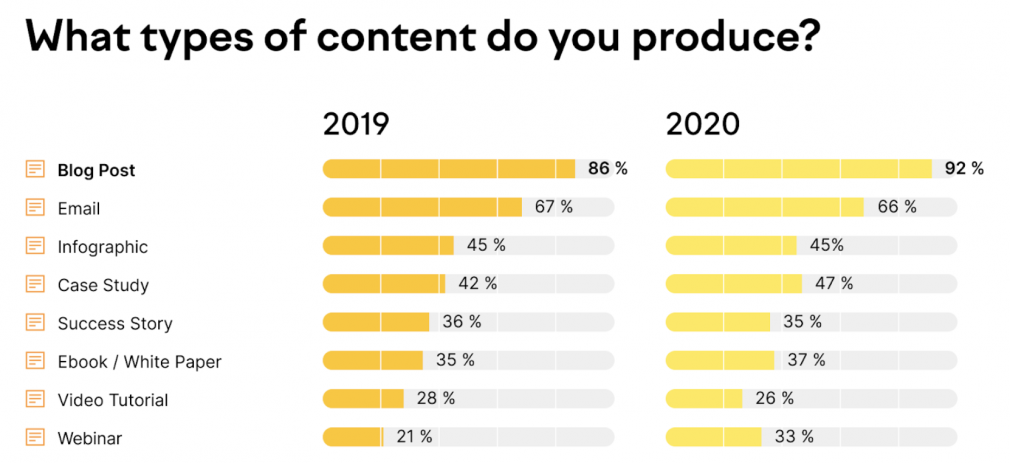
There are a few very good reasons for that. Blogging, if done diligently and consistently, can be a fantastic way of driving more traffic to a website and boosting brand authority.
Blog posts should accurately reflect the brand's identity, usually in a friendly, relaxed way. This strategy applies to complex topics, too, with the content writer being able to successfully turn them into engaging pieces that convert into leads.
To maximize the benefit of articles, you'll want them to rank in search engines, bring new potential customers, and build long-term relationships. So, you need to:
- Find the right keywords
- Find questions that people ask
- Identify and map search intent
- Check competitors' articles for your target keywords
- Gather original data
Here are some writing tips to ensure you create an SEO-friendly article:
- Check use of keywords. Use keywords effectively in the text, H1 header, meta title, meta description, and subheadings.
- Make sure the title is perfectly optimized. You want the title to be enticing and offer the reader information that they need, while also meeting search engine requirements.
- Check the optimization of the meta description. Explain the benefits of your article and make it unique. You can check the correctness and effectiveness of your titles and meta descriptions with the help of On Page SEO Checker or Site Audit.
- Make sure the introduction is magnetic. Get people "hooked" in the introduction by addressing their feelings, as well as adopting other effective methods.
- Make sure the copy is easily read. Readable copy will have a good H2, H3, and H4 structure, skimmable headlines that inform without reading, clear and informative paragraphs, bullet points, and numbered lists.
- Check the links to relevant on-site and off-site resources. Link to reliable external content to build trust around your copy, and to internal content that guides users through their customer journey.
If you work with a writer, then our SEO Copywriting Guide will explain to you how to evaluate the work of a writer. Alternatively, if you do your own writing, it is recommended to use SEO Writing Assistant, which analyzes your target keywords and suggests how to make your copy more readable and SEO-friendly in real time.
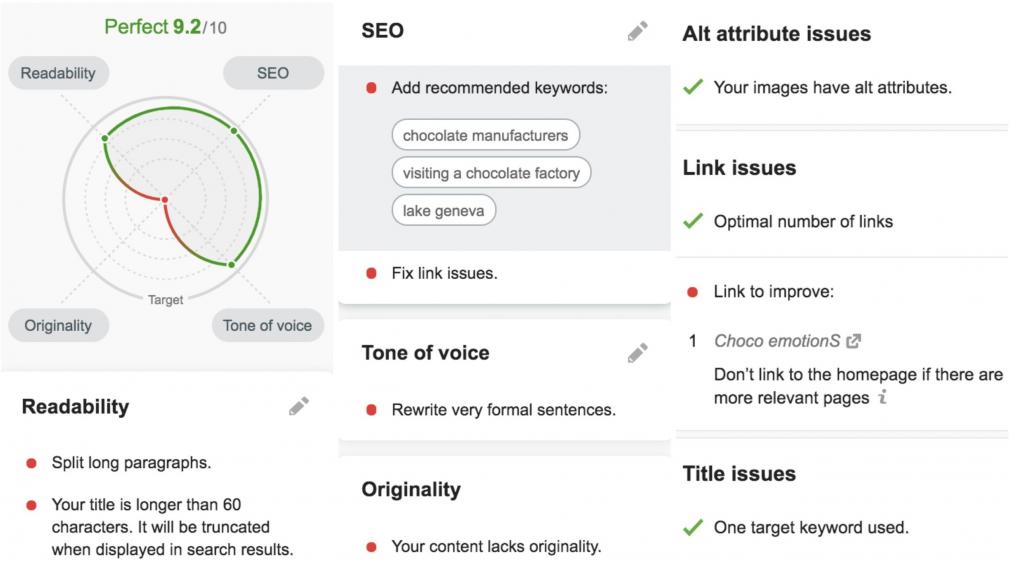
Product Content
In the eCommerce business, well-written product descriptions are the key to convincing the reader that your product offers real value to them in a way that resonates.
We have some tips for you to write effective product descriptions that give your readers the confidence to make a purchase, and for you to rank well on search engine results pages.
- Cater to buyer personas. Use data, market trends, customer profiles, and similar information to understand your ideal customer, and use suitable types of humor, relatable references, and the right tone of voice.
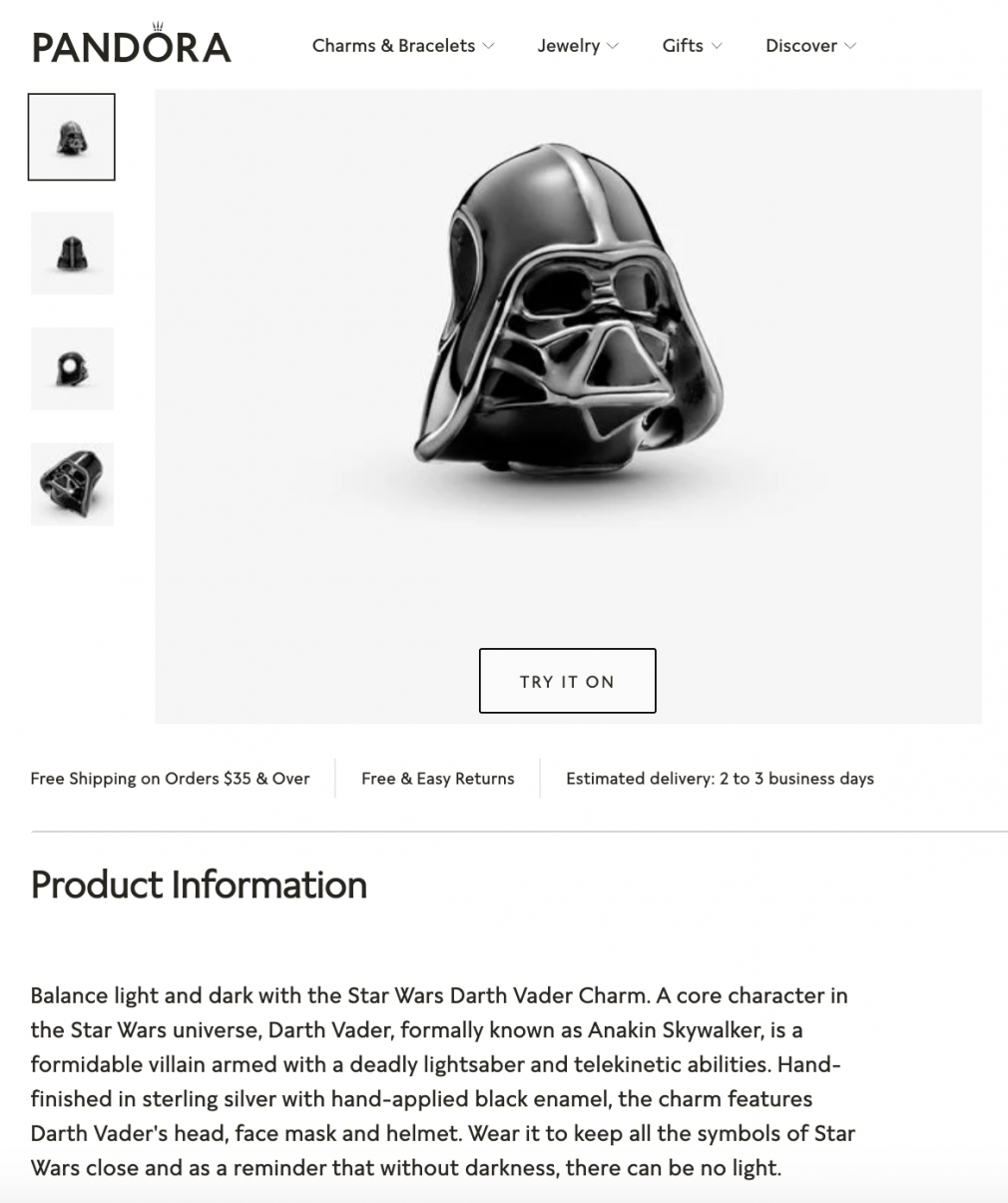
- Provide value to the customer. Aim to embody the values and goals of your target audience in the description, and instead of describing the product's features, focus on the value it creates for your customers.
- Employ meaningful, technically proficient writing. Resist the temptation to write that your product is "very", "really", or "especially", or that it has "excellent quality" and offers "great value".
- Know SEO Basics. Use keywords naturally in the body text (as well as the metadata and title), avoid sentences over 20 words, and use interlinks.
We also want to warn you against using:
- Fill-In-The-Blanks Product Description Templates, or
- Product Description Generators
Website Сontent
Your website is at the core of your content, as it includes all the essential information your business must promote to build its presence online. Website copy encompasses a range of content, including your:
- Home page
- About us page
- Landing page (services and products)
- FAQ/Q&A
- Contact us page
Here are some of our top writing tips to help you motivate users to take an action (such as making a purchase, subscribing to your blog, or joining your mailing list):
- Help readers navigate. Help readers who are not familiar with your brand by adding links to what you offer, and explaining what they may gain from interacting with you.
- Talk to readers as you would to a friend. Use direct addressing ("you," "I," and "we") and sentence structure ("You can order our services" instead of "Our services can be ordered") to sound less formal.
- Talk in layman's terms. Replace professional terminology with simpler alternatives, and explain what you offer in simple words.
- Demonstrate proof that the CTA is worth it. Back up any statements you have made about your products or services with success stories, original research data, customer testimonials, a relevant expert's biography, or partnerships.
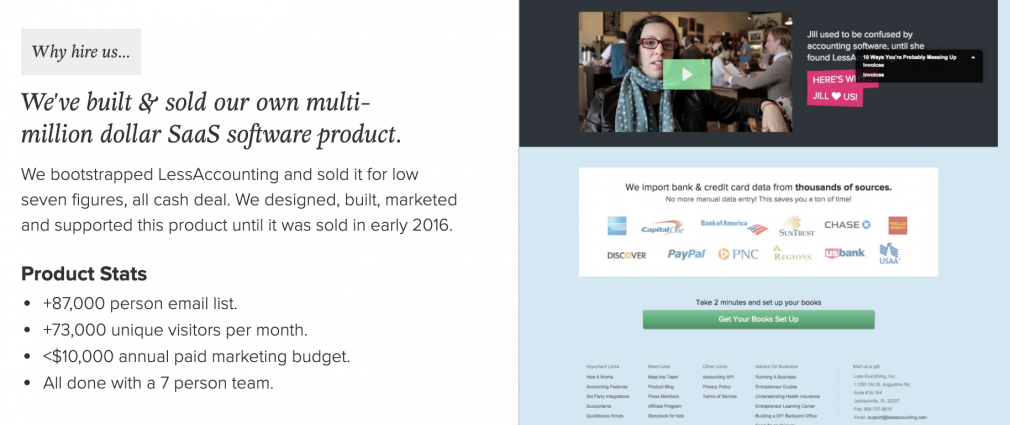
For more tips, read the full Writing Website Content Guide.
Email Newsletters
Email newsletters are important for retargeting customers and maintaining engagement with your company's base. They can provide a diverse range of information including company and industry news, product information, or sales incentives. In the past year, 55% of marketers have reported that they owe their most lucrative ROI measurements to email marketing.
As we learned from the Top Content Marketing Trends research, marketers who want to keep pace with the modern world are looking to customization and personalization. Emails that are highly segmented tend to have higher performance levels for metrics such as open rate and clickthrough rate than emails that aren't personalized.
Here are some tips for writing effective emails:
- Hook the reader with the title. Your subject line should be catchy. It's great if you can add humor, but make sure the headline is clear. The user must understand what the email is about.
- Write about the potential benefit to users - not about your business. Opt for language like "you can get" over "we offer", and think about how the user will benefit if they take the action you are asking them to. For example, if you sell multicookers, then the user benefit is not purchasing the product, but having more free time for other tasks.
- Be clear about what you are proposing. This applies to both text and visual design. The CTA button should be the brightest and most attractive element on the page, and the text should state the main idea from the first or second paragraph. Remember that you don't have much time to get the reader's attention, so try to be brief.
You can find even more ideas for writing emails – especially if there are certain holidays on the horizon – in our recommendations for Writing Festive E-commerce Emails That Shine.
Press Releases
Writing a press release is the first step towards attracting media attention, and encouraging them to write a story about your product, service, or event.
For the text to be effective, here are the questions you need to answer clearly:
- Who or what is it about?
- What is happening/has happened?
- Where did it take place/is taking place?
- When did it happen/will be happening?
- Why does it matter?
There are also rules concerning word count, statistics, seasonality, and contact details that you should consider. For more information, read our 7 Easy Steps to Writing a Press Release, and download the free press release template.
Ebooks
At least 37% of businesses create ebooks on a regular basis. There are many goals that you may want to achieve by writing an ebook, such as establishing yourself as an industry expert, moving potential customers down the sales funnel, educating readers on your brand or product.
The desired goal defines which sections you should include in your ebook; for example, a section with tables and figures is more applicable to a research paper than to a company playbook or other format.
Here's what you need to know about the different tactics of writing an ebook:
- Choose the topic very carefully. It's better to spend time researching the right topic than to waste months writing content that no one will read.
- Attract readers with a captivating title. Choose the final title only after writing the body to make sure that it is relevant to what you promise to explore. Make it specific, credible, and show the problem your readers will be able to solve.
- Help readers navigate with a table of contents. Add a table of contents to present the ebook structure, and allow the reader to quickly access its specific parts.
- Back up your words with data. Increase your ebook's credibility by explaining your methods and linking to credible resources.
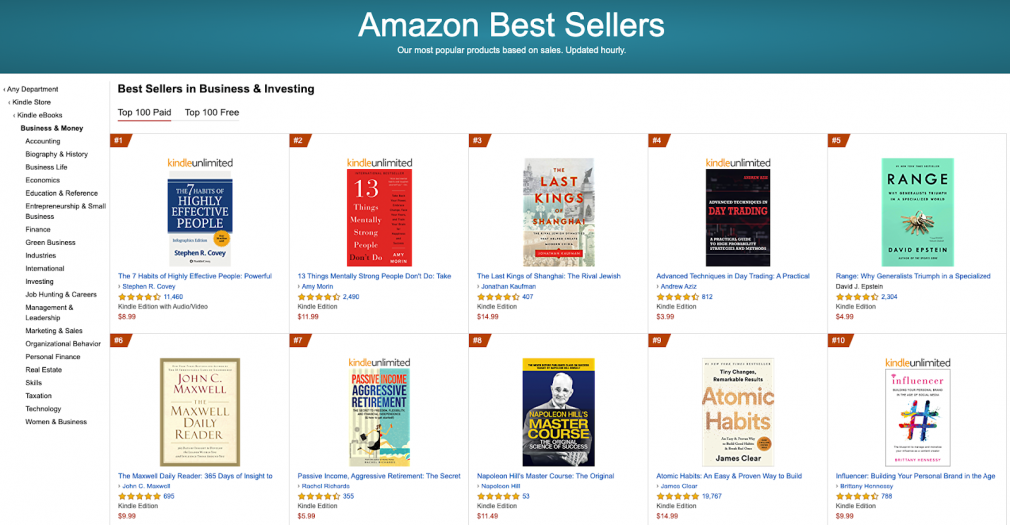
Read our Guide to Writing an Ebook for Your Business (from ideas to publishing and marketing), and download our free Ebook template.
Outsourcing Content
Creating quality content is difficult to do regardless of size, and it can become an even bigger challenge when you're working on scaling. To up your content development game, you can use either in-house resources or outsource the content.
-
- Outsourcing Cons
- Outsourcing Pros
- 3 Signs You're Ready To Outsource
- How To Outsource Content Writing in 5 Easy Steps
- Step 1: Find Service Providers and Negotiate the Details
- Step 2: Test Out Your Content Provider
- Step 3: Create a Perfect Brief
- Step 4: Carry Out Quality Assessment
- Step 5: Track the Content's Performance
Let's take a look at the common fears that people may perceive around outsourcing.
Outsourcing Cons
The biggest actual negative of outsourcing is that it will use up some of your marketing budget. Since it may take some time to see results from your content marketing, and you'll often need a consistent content effort to get said results, some brands may worry about spend.
Here are some more "cons" to outsourcing:
- You don't have an existing relationship with the writer. You might be worried about the freelancer's ability or consistency, and whether they'll follow through on the task at hand. To prevent a disappearing act, make sure that you're either getting a contract signed, or using a content writing service with a large pool of experienced writers.
- Freelancers may not understand or be able to capture your brand voice as well as an in-house team member. Freelancers often have multiple clients, so it's easy to understand why brands worry that the writer won't be able to capture their voice. If you're hiring someone with industry experience and you share information like your brand's USP and style guide, you'd be surprised how well writers can adapt to your brand.
- Freelancers may not be willing to work with your team. If you have open channels of communication that work for your team and the writer, this shouldn't be an issue. You can use Slack, Google Hangouts, email, or other project management tools for this. Just make sure you're asking your contractor to get in touch if they have any questions, and account for the potential need for revisions along the way.
- Writers won't be interested enough or able to write about my specific industry. Brands with technical or highly niche topics might worry that freelance writers can't help, whether because of a lack of access to information, or because of an unwillingness to find it. Think topics like "how to set up invoice factoring with international clients," or advanced, technical programming articles with huge blocks of code. There are, however, freelancers in every specialty and niche, as well as content platforms that can help you find the right one.
Working with a reputable writer or content agency can often relieve you of these fears. This will allow you to focus on other mission-critical tasks, while the time-consuming content is left to the experts.
Outsourcing Pros
According to B2B Content Marketing study, 84% of marketers in B2B companies outsource their content creation activities. This may suggest that fewer businesses are opting to have in-house writers.
There are an enormous number of benefits that can come from outsourcing content, especially when you work with a strong, experienced writer with knowledge of SEO and content strategy.
Here are the key benefits to consider:
- You can focus your time on high-level strategy instead of writing. When you aren't stuck spending time researching and creating blog posts, you can focus on the high-level strategy that needs your attention the most.
- It's often more cost-effective to outsource than to hire staff members. This is particularly true if you want to hire an expert writer with experience in your field. Aside from the flat rate and salary differences, you also won't have to spend money on taxes, benefits, and training like you would with an employee.
- You can scale up or down as you see fit. If you need two blog posts this month, five the next, and zero after that, that's okay. Some freelancers may want to set up retainers, but many are happy to work on an as-needed basis. You pay for what you need, when you need it; you don't need to worry about justifying someone's salary. You can also hire as many writers as you need, when you need them.
- You can choose the payment methods that work for your company. While many freelancers and agencies have a preferred pay structure, you can search for what works for you, whether it's paying based on word count, hours worked, or a flat rate fee.
- Freelancers bring diverse experience and perspectives. Hiring a third-party writer or agency can offer expertise and insight into new strategies. They may also have a great way of looking at your content, business, or audience that you hadn't thought of yet. Sometimes getting an outsider's perspective can be invaluable.
Keep in mind that freelance writing is extremely competitive. Many strong writers are vying for good jobs with great clients who know what they want, so content marketplaces always have a vast pool of writers. Many have writers specializing in different niches, too, providing you with multiple options.
Content Marketplace
Get High-Quality Content From Expert Writers

3 Signs You're Ready To Outsource
If you're at one of the three following checkpoints, it may be time for you to outsource:
- You don't have the time to create enough content consistently . Let's say that you have a team member who handles your marketing. When your business is relatively small, they're able to handle blog creation, social media management, email marketing, and product updates. But as your social media posts get more engagement and you need to build more email campaigns, there's less and less time available for content writing.
- You're worried about your strategic skill set or your expertise in content creation. Great content isn't just about writing something that can educate your audience. It should also be strategic, well-researched, and interesting. If you aren't sure how to create and optimize resources that drive real business results, working with an expert will likely be the best call.
- You can't afford to hire a new staff member or delegate the task to an existing team member. Outsourcing, as we mentioned above, is much more cost-effective than hiring an in-house specialist. If you don't consistently have enough work available to hire another in-house writer (or if you don't have the budget), outsourcing is the way to go.
How To Outsource Content Writing in 5 Easy Steps
Step 1: Find Service Providers and Negotiate the Details
At this stage of the outsourcing process, you'll have a solid idea of what content formats you need, and how much content you need. Keeping this in mind, figure out how much of your marketing budget is required to make this possible.
If you know that you want two articles and three email campaigns per month and only have $1000, that will help you connect more quickly with the best-placed writer or service provider for you.
When you're looking for a service provider, you can also reach out to established content writers or look for content writing platforms (like our own Content Marketplace) that will help you connect with writers.
After you've chosen your writers or found a service, negotiate the most important details: payment schedules, contracts, and, if necessary, non-disclosure agreements (NDAs). Here's what you need to remember:
- Individual Freelancers
Established content writers may not be on content marketing platforms, and instead can be found through their own sites. They may also be more expensive to hire, and they'll have their own schedules, policies, and processes. Depending on what you need, this may work for or against you. When you hire an established writer, the biggest advantage is that you know exactly who will be doing the work for you.
Sometimes, though, established freelancers may get busy, or they may drop clients due to personal matters, busy schedules, or a change in the work that they do. Because of this, it may be best to have contracts with several writers so that you have a backup option available.
If you've decided to work with freelancers, get them to sign a contract as soon as possible. Many won't sign non-competes, but all should be willing to sign NDAs. This will protect your business information and strategy, and ensure they don't disclose that they've ghostwritten something for you. Finally, figure out a payment system that works for you both.
You can learn more about working with freelance writers here.
- Content Writing Platforms
Content writing platforms offer a more standardized approach, and potentially at a lower cost. In our Content Marketplace, for example, you know that you'll get a full article within 10 days from start to finish, and for a set flat fee.
If you're working with a marketplace, consider looking at subscriptions that allow you to pay for multiple pieces of content at once at a cheaper rate. With a Semrush Content Marketplace subscription, you can access stock photos, an integrated workspace, and get 20% off an annual subscription (or 10% off with a monthly plan). This can help you scale quickly and stay on budget.
Here are some other benefits of using Content Marketplace:
- You don't have to worry about extensive paperwork or contracts.
- Availability is guaranteed thanks to the vast pool of writers that come with diverse backgrounds and experience.
- We test the writers for you, ensuring that they have the necessary skills required.
You can find even more tips on How to Outsource Content Writing For Success here.
Step 2: Test Out Your Content Provider
When you've connected with a new content writer or a service, you may encounter the term "trial post." These are often shorter or slightly discounted blog posts that are designed to ensure that you and the writer are compatible.
As the client, you'll want to test out the content provider. We'll discuss more about how to assess the quality of the content itself, but following the trial post, take note of the following:
- The responsiveness of the writer or service provider, and if their timelines worked with yours.
- How many revisions were needed.
- How well they were able to optimize the post for your goals.
- How well the content aligned with your brand and your audience's expectations.
Sometimes, the first post may require a few more revisions, but after that it should be smooth sailing. If you have doubts about a writer or service, it's at your discretion whether you give them another shot or move on.
Take advantage of that trial post, and ask to see relevant samples first. You can see a trial post from our Content Marketplace here.
Step 3: Create a Perfect Brief
Your content brief should include all of the following elements:
- Your target audience
- Your goals
- The ideal word count (or minimum word count)
- The site the post will appear on
- Your brand voice or style guide
- Topic or keyword information
- Any additional detailed information you want the writer to know, including links to any products you want them to promote
Read our instructions on how to create the perfect brief, and also find out what you need to know about data, keywords, and search intent to assign a task to an SEO copywriter.
Step 4: Carry Out Quality Assessment
You'll want to check the quality of the writing as it's coming back to you. Here are our recommendations on how to do this:
- Manual review
First, look at the article itself and do a manual review. Does it adhere to your brand's style guide? Is the content what you were looking for?
- Using special tools
If it looks good at first glance, it's time to dig a little deeper (especially if it's the first few times you're working with a new writer or service provider). Using third-party tools can help you assess SEO potential or reading level scores.
For example, the closer the score in SEO Writing Assistant is to 10, the more optimized the text is and the higher the chances are of it ranking well.
- Involving an expert/editor
If your article is product or industry-specific, have the right team member review the article themselves, too. Someone who works in a hospital, for example, may be able to tell you whether an article about heart disease is well-written, but a doctor might catch minor inconsistencies in wording that ultimately make it inaccurate.
Having a product specialist or industry expert write the post is ideal, but if this is not possible then they should at least review it. Compare it against your brand's style guide again for good measure.
Step 5: Track the Content's Performance
The fact that your content is published doesn't mean you're done with it! You'll also want to track its success long-term.
Tracking your content's performance will help you assess what types of content are working for your business, and what you should create more of moving forward.
The following KPIs are typically good to watch for content marketing:
- Average time spent on page. You want users to read your content from start to finish, so if someone is leaving within ten seconds, it may mean that your content didn't align with their search intent or that it otherwise wasn't what they were looking for.
- Total views. If SEO is your primary focus, you should see an increase in traffic coming to you through search on these pages.
- Click-through rates for internal links. You want to see people bouncing around on your site instead of bouncing off. If they're clicking, it indicates interest.
- Actions taken. If you had an article, whitepaper, or other resource created as a lead magnet, see how many people are downloading it.
Check out our full list of marketing metrics to track for content marketing.
Final Thoughts
Bringing your 'A' game to content development means tackling each stage of content creation: research, planning, and writing. By carefully considering how you can best optimize your content performance, you will be able to target your audience in a far more efficient way.
You can use both the internal resources of your company and order content from professional freelancers. But remember that you shouldn't be afraid of working with freelancers, as an experienced content writer will know all the recommendations listed in this article and will free you from time-consuming content writing tasks.
Content Marketplace
Get High-Quality Content From Expert Writers

5 Types Of Hooks For Writing
Source: https://www.semrush.com/blog/content-writing-how-to-write-and-order-different-types-of-content/
Posted by: davisdogried.blogspot.com

0 Response to "5 Types Of Hooks For Writing"
Post a Comment